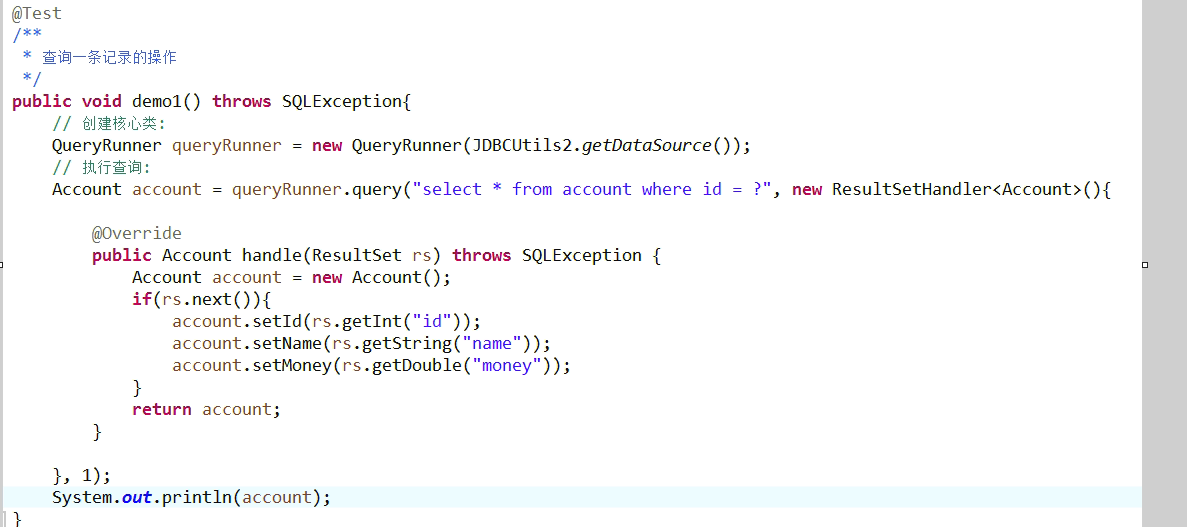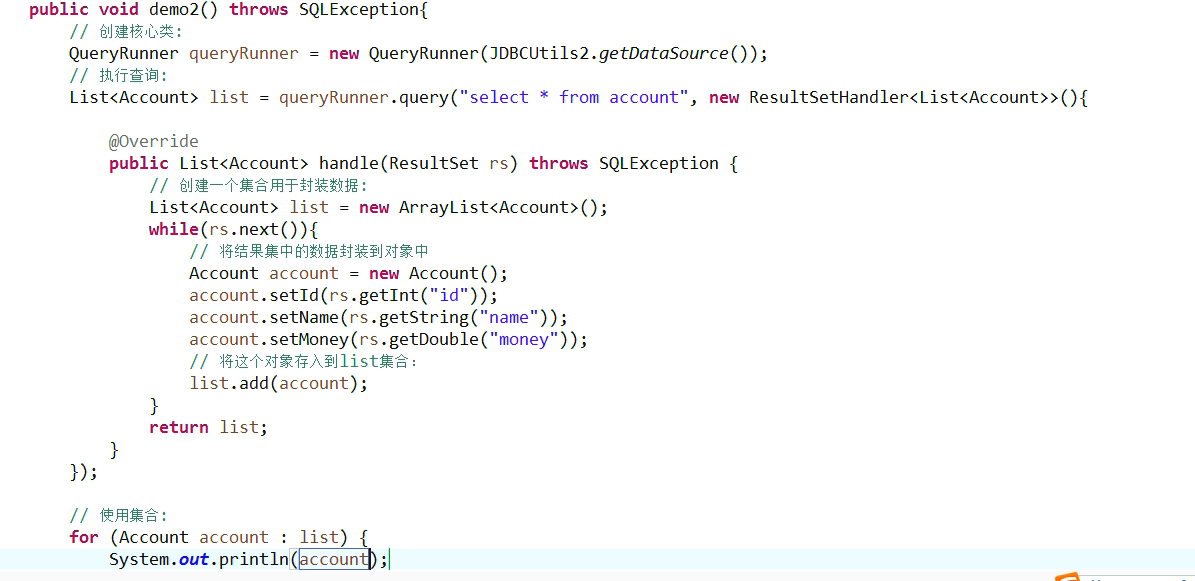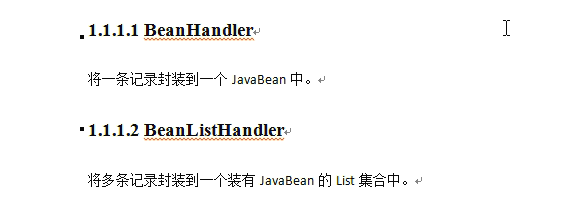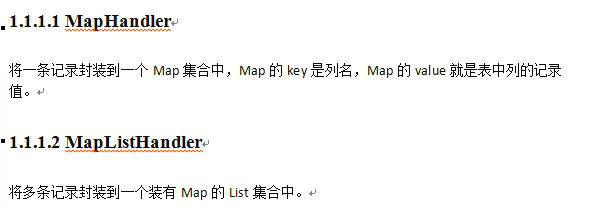JDBC
前言
在JDBC-01当中,我们简单地学习了有关JDBC的一些基本操作,现在我们再一次进行深入的学习。
正文
事务
首先,我们来学习的是JDBC中事务的运用,那么让我们再次了解一下事务的概念。
事务的概念
事务指的是逻辑上的一组操作,组成这组操作各个逻辑单元要么全部成功,要么全部失败。
关于事务的API

commit()
![]()
rollback()
![]()
异常案例:
package com.charles.jdbc.high; import org.junit.Test; import java.sql.Connection; import java.sql.PreparedStatement; import java.sql.SQLException; /** * 有关事务的案例 * 转账案例 * @author Charles */ public class Demo01 { @Test public void demo(){ Connection conn = null; PreparedStatement pste = null; try { // 加载驱动 + 获取连接 conn = org.charl.Demo.getConnection(); // 编写SQL String sql = "update account set money = money + ? where name = ?"; // 预编译 pste = conn.prepareStatement(sql); // 转账过程 pste.setInt(1,-1000); pste.setString(2,"aaa"); pste.executeUpdate(); pste.setInt(1,1000); pste.setString(2,"bbb"); pste.executeUpdate(); // 因为这个错误,导致异常的发生 int i = 1 / 0; } catch (SQLException e){ e.printStackTrace(); } finally { // 资源释放 org.charl.Demo.release(pste,conn); } } }
修改后的案例
package com.charles.jdbc.high; import org.junit.Test; import java.sql.Connection; import java.sql.PreparedStatement; import java.sql.SQLException; /** * 有关事务的案例 * 转账案例 * @author Charles */ public class Demo01 { @Test public void demo(){ Connection conn = null; PreparedStatement pste = null; try { // 加载驱动 + 获取连接 conn = org.charl.Demo.getConnection(); // 开启事务 conn.setAutoCommit(false); // 编写SQL String sql = "update account set money = money + ? where name = ?"; // 预编译 pste = conn.prepareStatement(sql); // 转账过程 pste.setInt(1,-1000); pste.setString(2,"aaa"); pste.executeUpdate(); pste.setInt(1,1000); pste.setString(2,"bbb"); pste.executeUpdate(); // 因为这个错误,导致异常的发生 // int i = 1 / 0; conn.commit(); } catch (SQLException e){ // 回滚事务 try { conn.rollback(); } catch (SQLException ex) { ex.printStackTrace(); } e.printStackTrace(); } finally { // 资源释放 org.charl.Demo.release(pste,conn); } } }
这样,数据就会进行回滚,保证了数据的安全性。
连接池
概念:连接池是创建和管理一个连接的缓冲池的技术,这些连接准备好被任何需要它们的线程使用。
好处(作用):
- 减少连接创建时间
- 简化的编程模式
- 受控的资源使用
- 提高连接的效率
连接池原理:
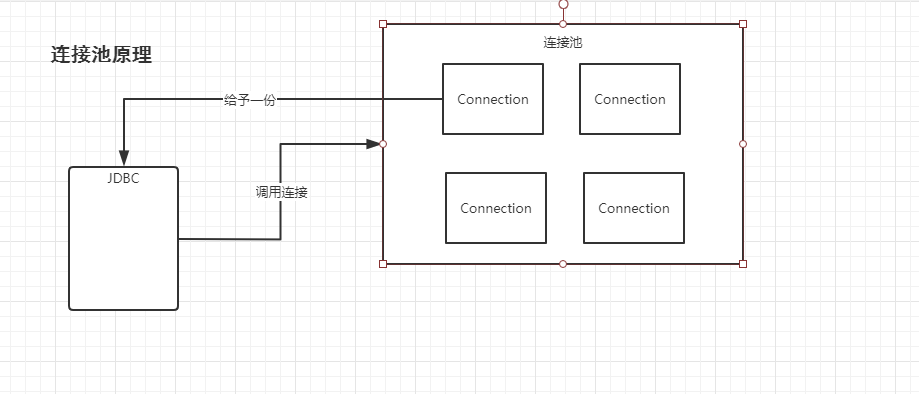
自定义连接池:
我们可以利用DataSource接口来实现一个自定义连接池
具体步骤:
-
-
重写一个getConnection方法
-
初始化多个连接在内存中
-
/** * 自定义连接池 * @author Charles */ public class MyDataSource implements DataSource { // 在初始化的时候提供一些连接 private List<Connection> connectionList = new ArrayList<Connection>(); public MyDataSource(){ // 初始化连接 for (int i = 1; i <= 4; i++){ // 向集合中存入连接 connectionList.add(org.charl.Demo.getConnection()); } } // 获得连接的方法 @Override public Connection getConnection(String username, String password) throws SQLException { Connection conn = connectionList.remove(0); return conn; } // 归还连接的方法 public void addBack(Connection conn){ connectionList.add(conn); }
代码案例:
package jdbc.datasources; import org.junit.Test; import javax.management.relation.Relation; import java.sql.Connection; import java.sql.PreparedStatement; import java.sql.ResultSet; import java.sql.SQLException; /** * 利用连接池的案例 */ public class Demo01 { @Test public void demo(){ Connection conn = null; PreparedStatement preparedStatement = null; ResultSet rs = null; MyDataSource md = null; try{ // 利用自定义的连接池注册驱动 + 获得连接 md = new MyDataSource(); conn = md.getConnection(); // 编写SQL语句 String sql = "select * from account"; preparedStatement = conn.prepareStatement(sql); rs = preparedStatement.executeQuery(); // 遍历结果 while (rs.next()){ System.out.println(rs.getInt("id") + " " + rs.getString("name") + " " + rs.getString("money")); } }catch (Exception e){ e.printStackTrace(); }finally { // 释放资源 if (preparedStatement != null){ try{ preparedStatement.close(); } catch (SQLException e){ e.printStackTrace(); } preparedStatement = null; } if (rs != null){ try { rs.close(); }catch (SQLException e){ e.printStackTrace(); } rs = null; } // 归还连接 md.addBack(conn); } } }
Druid 是阿里旗下的开源连接池产品,使用非常简单,可以与Spring 框架进行快速整合。
Maven导包
<!-- https://mvnrepository.com/artifact/com.alibaba/druid --> <dependency> <groupId>com.alibaba</groupId> <artifactId>druid</artifactId> <version>1.1.21</version> </dependency>
基本代码实现
package com.charles.datasource.demo1; import com.alibaba.druid.pool.DruidDataSource; import org.junit.Test; import java.sql.Connection; import java.sql.PreparedStatement; import java.sql.ResultSet; import java.sql.SQLException; public class DruidDemo1 { @Test public void demo01(){ Connection connection = null; PreparedStatement preparedStatement = null; ResultSet resultSet = null; try { // 使用连接池 DruidDataSource druidDataSource = new DruidDataSource(); druidDataSource.setDriverClassName("com.mysql.jdbc.Driver"); druidDataSource.setUrl("jdbc:mysql:///web_test3"); druidDataSource.setUsername("root"); druidDataSource.setPassword("1234"); // 获得连接 connection = druidDataSource.getConnection(); // 编写SQL String sql = "select * from user"; // 预编译sql preparedStatement = connection.prepareStatement(sql); resultSet = preparedStatement.executeQuery(); while (resultSet.next()){ System.out.println(resultSet.getInt("id") + " " + resultSet.getString("username") + " " + resultSet.getString("password")); } } catch (SQLException e) { e.printStackTrace(); } finally { try { connection.close(); } catch (SQLException e) { e.printStackTrace(); } try { resultSet.close(); } catch (SQLException e) { e.printStackTrace(); } try { preparedStatement.close(); } catch (SQLException e) { e.printStackTrace(); } } } }
当然也可以将这些数据库信息向外面引入,即创建一个db.properties
代码实现:
单元测试类
@Test public void Demo02(){ Connection connection = null; PreparedStatement preparedStatement = null; ResultSet resultSet = null; try { // 使用连接池 Properties properties = new Properties(); properties.load(new FileInputStream("src/main/resources/db.properties")); DataSource dataSource = DruidDataSourceFactory.createDataSource(properties); // 获得连接 connection = dataSource.getConnection(); // 编写SQL String sql = "select * from user"; // 预编译sql preparedStatement = connection.prepareStatement(sql); resultSet = preparedStatement.executeQuery(); while (resultSet.next()){ System.out.println(resultSet.getInt("id") + " " + resultSet.getString("username") + " " + resultSet.getString("password")); } } catch (SQLException | FileNotFoundException e) { e.printStackTrace(); } catch (IOException e) { e.printStackTrace(); } catch (Exception e) { e.printStackTrace(); } finally { try { connection.close(); } catch (SQLException e) { e.printStackTrace(); } try { resultSet.close(); } catch (SQLException e) { e.printStackTrace(); } try { preparedStatement.close(); } catch (SQLException e) { e.printStackTrace(); } } }
db.properties
# 连接设置
driverClassName=com.mysql.jdbc.Driver
url=jdbc:mysql:///web_test3
username=root
password=1234
# 初始化连接
initialSize=10
# 最大连接数量
maxActive=50
# 最大空闲连接
maxIdle=20
# 最小空闲连接
minIdle=5
# 超时等待时间(以毫秒为单位)
maxWait=60000
C3P0连接池
C3P0是一个开源的JDBC连接池,它实现了数据源和JNDI绑定,支持JDBC3规范和JDBC2的标准扩展。
使用方法与Druid相类似
Maven导包
<!-- https://mvnrepository.com/artifact/com.mchange/c3p0 --> <dependency> <groupId>com.mchange</groupId> <artifactId>c3p0</artifactId> <version>0.9.5.2</version> </dependency>
基本代码实现
package com.charles.datasource.demo1; import com.mchange.v2.c3p0.ComboPooledDataSource; import org.junit.Test; import java.beans.PropertyVetoException; import java.sql.Connection; import java.sql.PreparedStatement; import java.sql.ResultSet; import java.sql.SQLException; public class C3p0 { @Test public void demo01() { Connection connection = null; PreparedStatement preparedStatement = null; ResultSet resultSet = null; try { // 使用连接池 ComboPooledDataSource DataSource = new ComboPooledDataSource(); DataSource.setDriverClass("com.mysql.jdbc.Driver"); DataSource.setJdbcUrl("jdbc:mysql:///web_test3"); DataSource.setUser("root"); DataSource.setPassword("1234"); // 获得连接 connection = DataSource.getConnection(); // 编写SQL String sql = "select * from user"; // 预编译sql preparedStatement = connection.prepareStatement(sql); resultSet = preparedStatement.executeQuery(); while (resultSet.next()) { System.out.println(resultSet.getInt("id") + " " + resultSet.getString("username") + " " + resultSet.getString("password")); } } catch (SQLException e) { e.printStackTrace(); } catch (PropertyVetoException e) { e.printStackTrace(); } finally { try { connection.close(); } catch (SQLException e) { e.printStackTrace(); } try { resultSet.close(); } catch (SQLException e) { e.printStackTrace(); } try { preparedStatement.close(); } catch (SQLException e) { e.printStackTrace(); } } } }
当然,C3P0连接池也可以通过外部配置文件引用
具体代码实现:
c3p0-config.xml配置文件
<?xml version="1.0" encoding="utf-8"?> <c3p0-config> <default-config> <property name="driverClass">com.mysql.jdbc.Driver</property> <property name="jdbcUrl">jdbc:mysql:///web_test3</property> <property name="user">root</property> <property name="password">1234</property> <property name="initialPoolSize">5</property> <property name="maxPoolSize">20</property> <property name="minPoolSize">5</property> </default-config> </c3p0-config>
单元测试类
@Test public void Demo02(){ Connection connection = null; PreparedStatement preparedStatement = null; ResultSet resultSet = null; try { // 使用连接池 ComboPooledDataSource DataSource = new ComboPooledDataSource(); DataSource.setDriverClass("com.mysql.jdbc.Driver"); DataSource.setJdbcUrl("jdbc:mysql:///web_test3"); DataSource.setUser("root"); DataSource.setPassword("1234"); // 获得连接 connection = DataSource.getConnection(); // 编写SQL String sql = "select * from user"; // 预编译sql preparedStatement = connection.prepareStatement(sql); resultSet = preparedStatement.executeQuery(); while (resultSet.next()) { System.out.println(resultSet.getInt("id") + " " + resultSet.getString("username") + " " + resultSet.getString("password")); } } catch (SQLException e) { e.printStackTrace(); } catch (PropertyVetoException e) { e.printStackTrace(); } finally { try { connection.close(); } catch (SQLException e) { e.printStackTrace(); } try { resultSet.close(); } catch (SQLException e) { e.printStackTrace(); } try { preparedStatement.close(); } catch (SQLException e) { e.printStackTrace(); } } }
这里注意,只要将配置文件放在默认路径下,它就会自动查找,不需要手动导入。
Commons DbUtils一个对JDBC进行简单封装的工具类库,它能够简化JDBC应用程序的开发,同时也不会影响程序的性能。
两个字:方便 -----> 一个字:懒
ArrayHandler 和 ArrayListHandler:

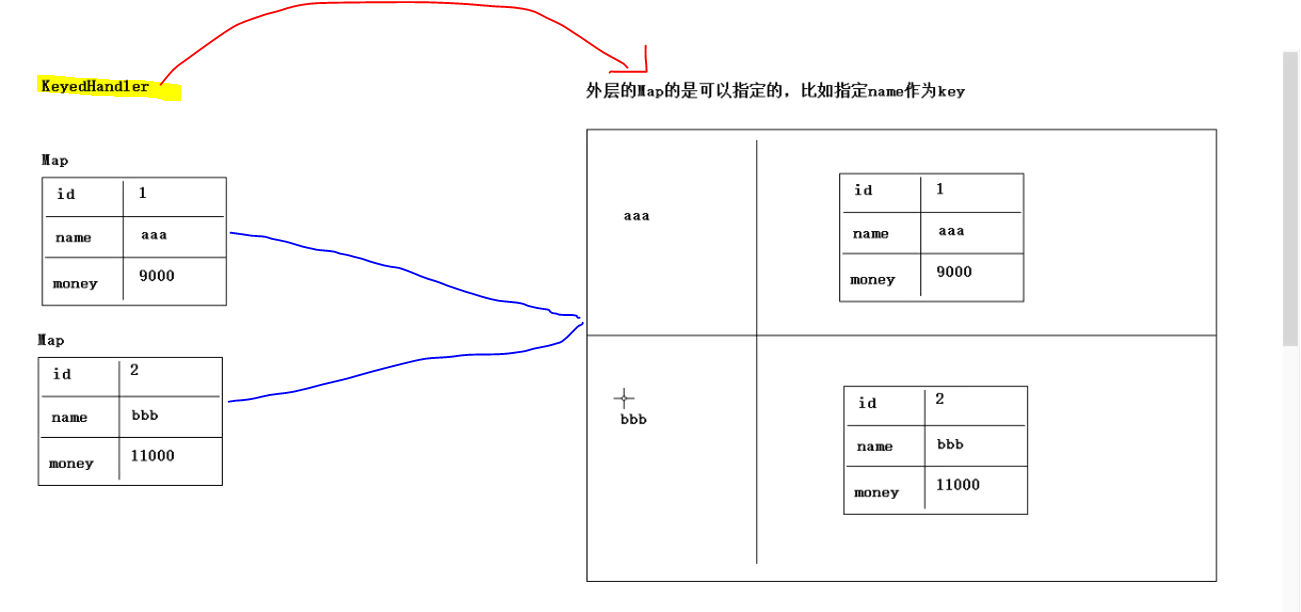
小结
以上便是JDBC的内容了,多练,练到烦了就会了。当然为了更偷懒,我们后期将会学到Mybatis,这个框架比JDBC更方便。
加油!
时间:2020-04-06 01:41:37



